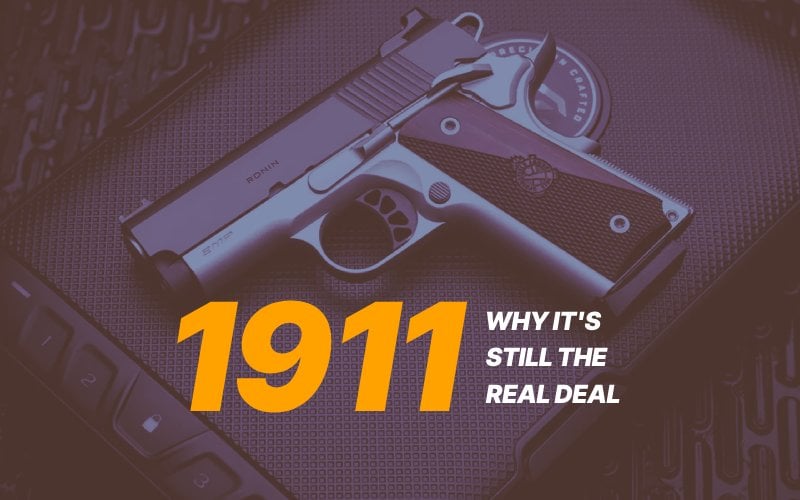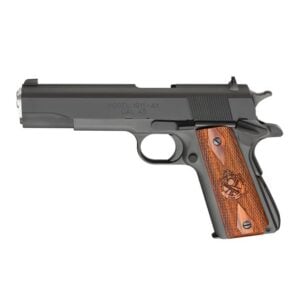The 1911 pistol has stood the test of time, proving itself as more than just a relic of history. In this post, we provide tangible reasons why 1911 is so popular as well as why you might want to opt for the 1911 for concealed carry or home defense. We also explain what 2011 is and how it’s different from its older brother.
Why 1911 Is Still a Great Gun
The 1911 remains incredibly popular today, and not just for its nostalgic charm or ties to major historical events. The reasons are more practical.
It Was a Military Sidearm
Here’s a note for those new to the platform wondering what the 1911 gun is. Designed by John Browning and adopted by the U.S. military in 1911, this pistol served as the standard-issue sidearm for over 70 years.
Why did 1911 became so popular? Well, one of the reasons was when veterans returned to civilian life, they often wanted to own the firearm they knew and relied on in service. Add to that a surplus of 1911s, accessories, and .45 ACP ammo, and it became an affordable, practical option for civilians.
After the original patent expired in 1928, American firearm manufacturers began producing their own versions of the 1911. Suddenly, it was accessible to a much wider audience.
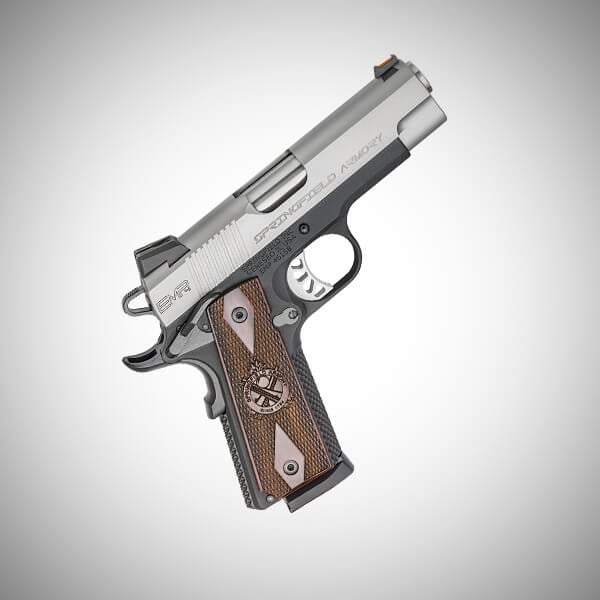
Trigger, Trigger, Trigger
The 1911 trigger is genuine perfection. Unlike the more common hinged triggers in modern polymer pistols, the 1911’s trigger has a straight-pull design, meaning it travels straight backward, which minimizes any chance of side-to-side movement. Operating in single-action mode, it’s crisp, clean, and consistent, with minimal creep. It feels like breaking a glass rod. Actually, even a “bad” 1911 trigger is better than most modern alternatives – exactly, it’s that good. Thanks to that, a 1911 pistol allows you to shoot faster and more accurately – that’s why you can see so many of these guns in competitions.
God’s Ergonomics
Ask anyone who loves the 1911, and they’ll likely tell you how it “just feels right” in the hand. The grip angle provides a natural point of aim and makes the firearm comfortable for small or large hands alike. Whether it’s the slim grip of a single-stack .45 ACP or the modern take in double-stack 2011 variants, the 1911 remains accessible to a variety of shooters.
This ergonomic advantage also means that even for new shooters, the 1911 tends to feel more controllable.
Smooth Operator
There’s a mechanical elegance to the 1911 that impacts how it handles recoil. Originally, 1911 guns have an all-metal frame that helps dampen felt recoil from .45ACP, making it easier to keep your sights on target during rapid fire. The added weight is a dealbreaker for many in search of a concealed carry pistol, but a godsend for anyone prioritizing shooting comfort. Plus, with a good gun belt, this becomes less of an issue.
Customization Galore
Gun enthusiasts love a platform that allows them to modify and personalize to their heart’s content. The 1911’s simplicity and longstanding design have opened the door for a staggering amount of aftermarket parts. From sights, hammers, and triggers to modern safety mechanisms, you can tweak nearly every single component of the gun.
Even budget-friendly 1911s, like Tisas or Rock Island Armory models, offer versatility in upgrades. Whether you’re looking to achieve better practical accuracy, improve cosmetic appeal, or make it competition-ready, there’s no shortage of options.
Versatility and Concealed Carry
The 1911 is a true multitasker. Whether you’d like a reliable carry gun, a competitive shooter, or a range toy, this platform can do it all. Though limited by its capacity (typically 7 or 8 rounds), many people trust it for concealed carry or as a home-defense tool. And for those wanting more capacity, double-stack options and the related 2011 style pistols are readily available.
Yeah, we mentioned that the weight of the 1911 isn’t particularly CC-optimal compared to polymers. However, 1911 guns for concealed carry, like Commander-size models, stand out for their slim profile that is easier to conceal without printing.
Legacy, Obviously
Beyond its functional superiority, the 1911 carries with it a sense of history and pride. Serving in two World Wars and carried by countless soldiers, law enforcement officers, and civilians, it has earned its legendary status. Owning one is often as much about preserving a piece of history as it is about enjoying the shooting experience.
It’s Simply Gorgeous
Beyond practicality or performance, the M1911 is an icon. Its classic steel-and-wood design exudes elegance and craftsmanship, reminiscent of a bygone era. Many enthusiasts liken it to an old muscle car or a Rolex watch – beautiful, timeless, and inherently cool.
Unlike many modern polymer pistols, which prioritize function over form, the 1911 is celebrated as a work of art.
“I don’t even shoot mine regularly,” one collector once admitted, “but I still can’t stop admiring how it looks and feels. There’s a certain magic to it that modern handguns lack.”
1911 Pistols for Rent
If you’re in the DFW area, swing by our shooting range and try out Springfield 1911 and more!
1911 vs Modern Polymer Pistols
Capacity Limitation
The biggest downside of the 1911 for some is its magazine capacity. Standard single-stack models in .45 ACP typically hold 7+1 rounds, while 9mm versions can hold up to 10+1. Meanwhile, modern polymer pistols offer up to 17+1 in 9mm.
However, it’s worth considering real-world usage. Many 1911 enthusiasts argue that accurate shot placement matters more than high capacity in most defensive situations. Plus, statistics show most self-defense encounters are resolved with just a few shots. And if you’re looking for more capacity without switching to polymer pistols, double-stack 2011 models are a great alternative.
For those in states with magazine capacity restrictions, the M1911’s 7+1 or 8+1 setup is compliant, making it an appealing option.
Reliability Concerns
The 1911 can be extremely reliable—but only when properly maintained. Quality magazines, regular cleaning, and choosing the right ammo are critical to ensuring its performance. On the other hand, firearms like Glocks and other modern pistols often handle adverse conditions better due to their looser tolerances, allowing them to function with less upkeep.
That said, a properly tuned 1911 from reputable brands such as Wilson Combat, Kimber, or Springfield Armory can hold its own against any modern firearm when paired with the right care and ammunition.
Best 1911 Brands for Your Budget / Application
When it comes to the best 1911, opinions flow like spent casings at a range. From dependable budget 1911 for concealed carry to high-end semi-custom pieces, the market for modern 1911s is vast and varied. Now, let us help you sort through the many options out there.
Best Budget 1911 Pistols
For shooters seeking a budget 1911, Rock Island Armory and Tisas consistently deliver good entry-level 1911s. RIA builds hard-wearing guns with no-nonsense performance, making their models an affordable way to experience classic 1911 concealed carry. Meanwhile, Turkish brand Tisas has been gaining traction, offering 1911 compact and full-size options with forged frames and slides for prices well under $600. Their Duty 1911 B9 and B45 options are particularly good.
Best Mid-Range 1911 Pistols
For those with a budget in the $1,000–$2,000 range, Dan Wesson comfortably sits at the top. Known for exceptional quality and tight tolerances, a Dan Wesson Specialist or Valor delivers the feel of a custom gun without the full custom price. Dan Wesson avoids MIM parts and instead uses forged components, which means higher durability and better performance.
Another worthy contender is the Springfield 1911 9mm line, specifically models like the Springfield EMP, TRP, and Operator. These pistols are praised for their ergonomic designs and overall reliability. Although some Springfield models use MIM parts, they remain duty-rated and are known for smooth operation out of the box.
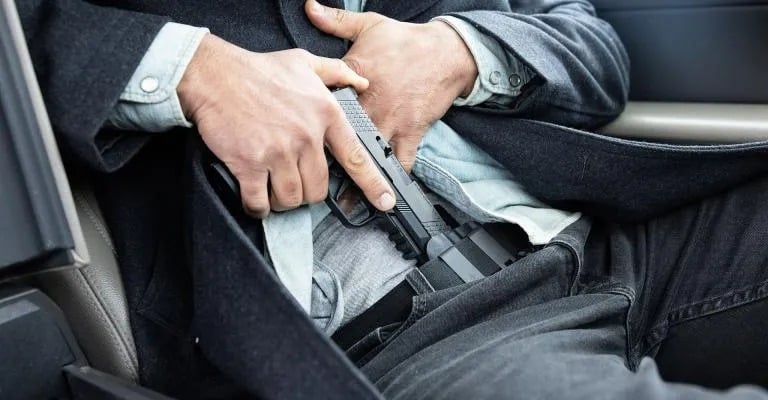
High-End and Custom 1911s
When stepping into the semi-custom and custom range, brands like Wilson Combat, Nighthawk, Ed Brown, and Les Baer are known for their “one gun, one gunsmith” philosophy, placing a strong emphasis on attention to detail. But one name that consistently manages to impress at a fraction of its price is Bul Armory. The Bul Armory Government offers a fit and finish that many compare to custom builds, all while maintaining a $900–$1,500 price tag. Plus, their offers boast smooth slides and factory triggers.
For competitors or those with serious cash on hand, investing in a Les Baer Custom 1911 is a choice that can’t go wrong. Their pistols offer incredible precision, with models like the Monolith boasting 1.5” group guarantees at 50 yards.
Compact 1911s for Concealed Carry
For those seeking a carry-friendly compact 1911 9mm, options like the Kimber Micro or Springfield EMP series are frequently mentioned. Kimber has long leaned into its reputation for making strikingly beautiful firearms, which perform excellently after careful break-in.
On the more affordable end of 1911 concealed carry, Ruger and Springfield models provide options worth exploring. The Springfield EMP 9mm 1911s in particular earn accolades within the category for their manageable size, lighter structure, and straightforward usability.
2011 Pistols for Rent
If you’re in the DFW area, swing by our shooting range and try out 2011 pistols from Staccato and Springfield!
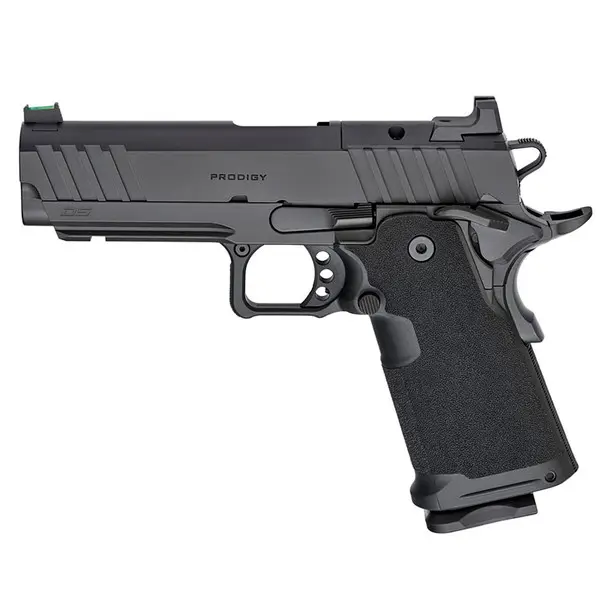
Springfield Prodigy 1911 DS
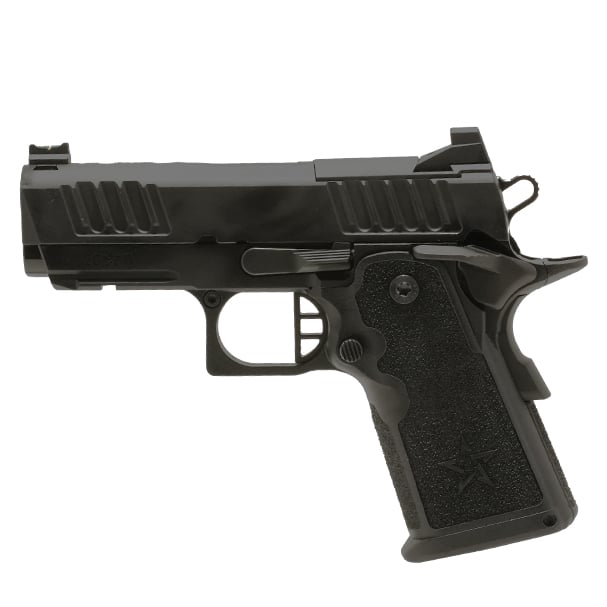
Staccato CS
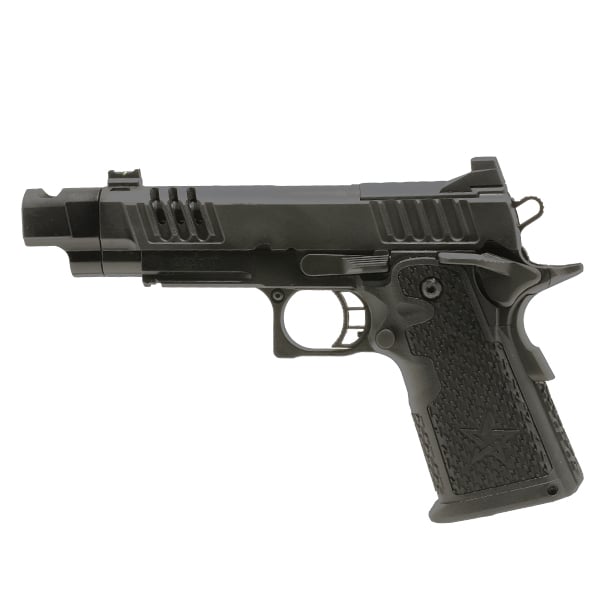
Staccato C2
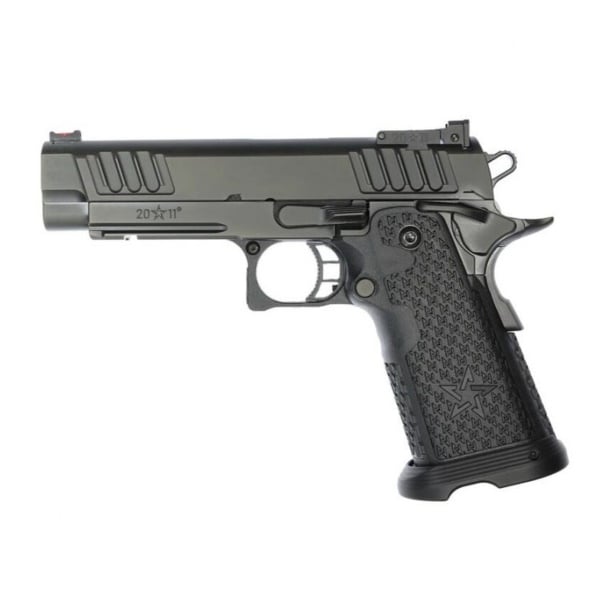
Staccato P
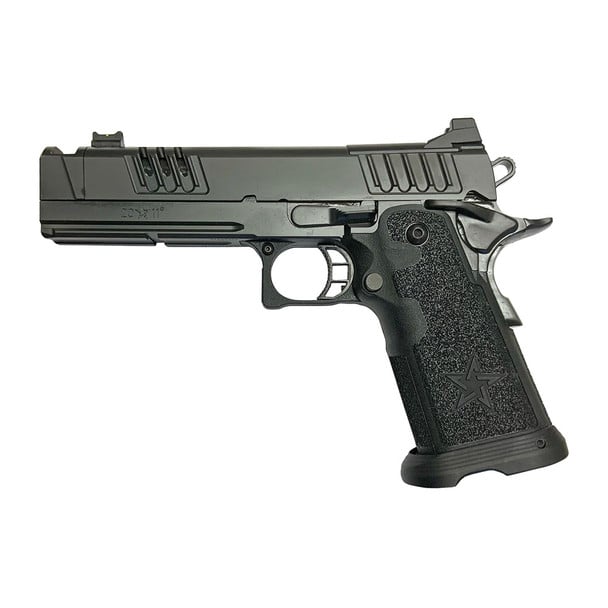
Staccato XC
1911 vs 2011
Now, if you’re wondering whether to go with a classic 1911 or its modern evolution, the 2011, let’s get into what makes them similar and different from each other.
But first, what is 2011? Well, some argue that the term should only apply to pistols made by Staccato (previously STI), as they trademarked “2011” in reference to their specific design. That’s technically true, but the firearms community at large uses 2011 to refer to any modern, double-stack, modular-framed handgun inspired by the classic 1911 design. This includes models like Springfield Prodigy, Kimber 2K11 Double Stack 1911, and Rock Island Tac Ultra HC. There’s even some gray area when people start debating whether a double-stack 1911 with a one-piece frame qualifies as a true “1911.” At the end of the day, split hairs if you want, but most of the differences are academic unless you’re vying for bragging rights at a competition or forum.
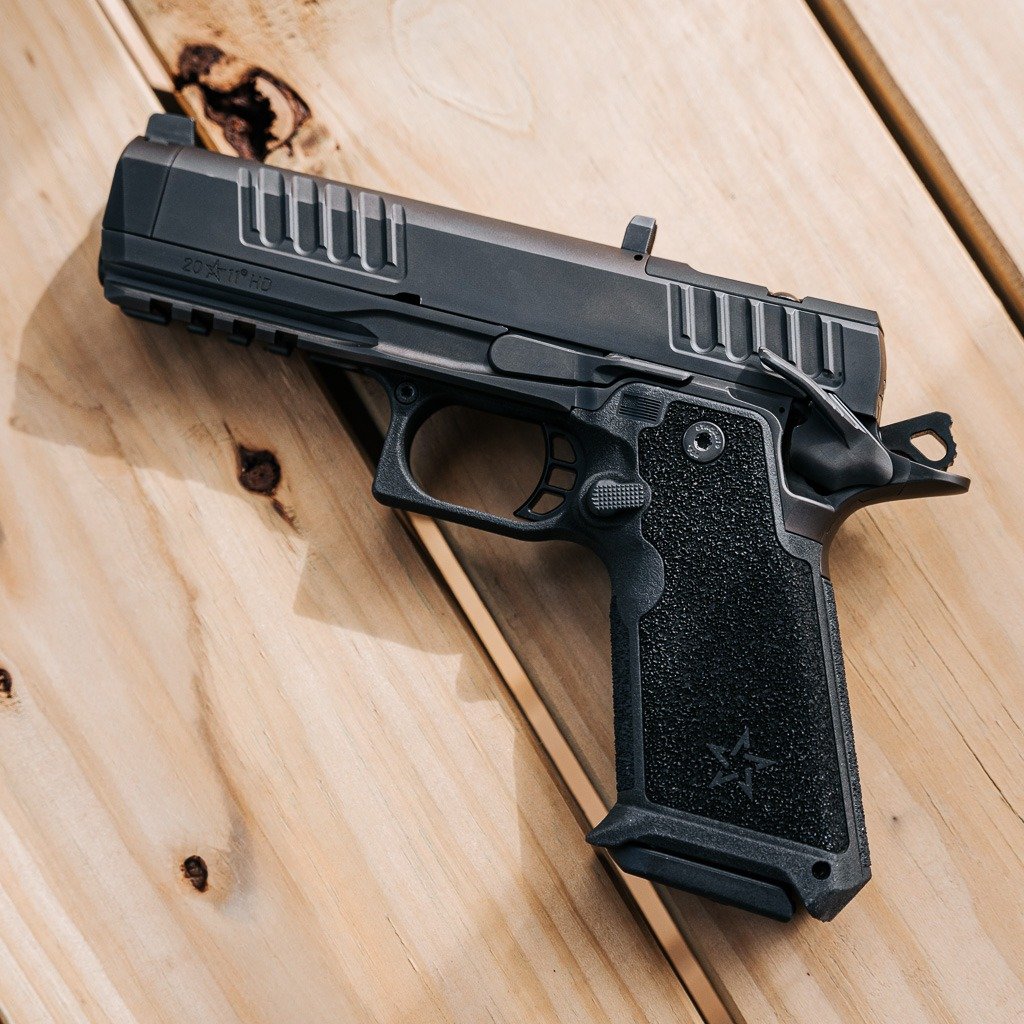
Design Differences Between 1911 and 2011
One of the biggest distinctions is in their frame construction. The 1911 features a one-piece, single-stack steel frame with the grip integrated into the frame itself. This design has that iconic, sturdy feel enthusiasts love.
The 2011, meanwhile, uses a modular two-piece frame. It pairs a steel or aluminum upper frame with a polymer grip module that can be swapped or customized easily. Plus, 2011s are all double-stack, with much higher capacity, holding 15, 17, or even 20+ rounds in 9mm.
The modularity of the 2011 adds flexibility. If the grip wears out or gets damaged, replacements are simple. The polymer grip also reduces weight while still being durable.
On the other hand, the solid, one-piece steel frame of the 1911 gives a heft and durability that fans swear by. It might not offer the same customization, but there’s undeniable charm in its timeless design and craftsmanship.
Performance and Handling
So, the 2011’s double-stack magazine means a wider grip and more rounds. For shooters with larger hands or those needing higher capacity (like for competitive or defensive use), this is a win. But if you have smaller hands and are okay with have like 8 round capacity, you might find the slim grip of the 1911 more comfortable.
Recoil also differs. The 1911’s heavier steel frame absorbs recoil brilliantly, making even .45 ACP feel manageable. The lighter polymer grip of a 2011 may mean slightly more felt recoil, though in 9mm, this difference is often negligible.
As for customization, the modular design of the 2011 allows for extensive upgrades—from grips to optics and barrels. For tinkerers seeking flexibility and personalization, this is a huge advantage. That said, the 1911 still has a robust aftermarket following, though some elements, like grips, can’t be swapped as easily.
Is the 2011 Carry-Material?
Many consider the larger, heavier 2011s to be overkill for EDC. Single-stack 1911s, with their slimmer profile, are often preferred for this purpose. However, we shoudn’t forget that there are smaller 2011 pistols, like the Staccato C2, that are purpose-built to balance capacity and concealability.
Sure, a 2011 isn’t going to feel as light as some micro-compact like a SIG P365 or Glock 43X. Most models weigh upwards of 30-40 ounces unloaded. But with the right holster (appendix carry works great for many users) and a proper gun belt, many carriers report that they actually forget they’re carrying such a robust firearm during daily activities.
